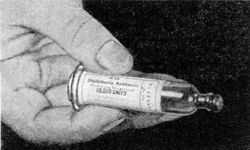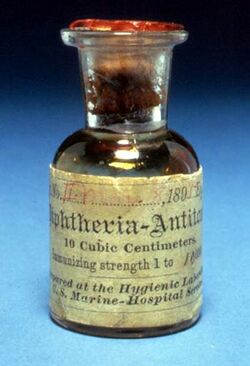Medicine:Diphtheria antitoxin
 Vial of 10,000 units, circa 1925. | |
| Clinical data | |
|---|---|
| AHFS/Drugs.com | Micromedex Detailed Consumer Information |
| Routes of administration | IM, IV |
| ATC code | |
| Identifiers | |
| ChemSpider |
|
Diphtheria antitoxin (DAT) is a medication made up of antibodies used in the treatment of diphtheria.[1][2] It is no longer recommended for prevention of diphtheria.[2][3] It is administered through injection into a vein or muscle.[2]
Side effects are common.[3] They include serum sickness and allergic reactions including anaphylaxis.[2] Diphtheria antitoxin is made from the blood plasma of horses that have been immunized against diphtheria toxin.[1] It works by neutralizing the toxins produced by Corynebacterium diphtheriae.[1]
Diphtheria antitoxin was developed and came into medical use in the late 1800s.[4] The 1901 diphtheria antitoxin contamination incident, in which the milk wagon horse used to culture the antitoxin became infected with tetanus, which contaminated vials of the antitoxin leading to the deaths of several children in the midwest United States,[5] led to the passage of the Biologics Control Act of 1902 and the 1906 formation of the U.S. Food and Drug Administration (FDA).[6][7] The celebrated 1925 serum run to Nome was a transport of the antitoxin by dog sled relay across the U.S. territory of Alaska across 674 miles (1,085 km) in 5 1⁄2 days, saving the small town of Nome and the surrounding communities from an epidemic of the disease.
Diphtheria antitoxin is on the World Health Organization's List of Essential Medicines.[8][9] In the United States it can be obtained from the Centers for Disease Control.[1] It is not available in many countries including many in Europe as of 2008.[10]
Chemistry

It is a solution of concentrated proteins, chiefly globulins, containing antibodies obtained from the blood of horses that have been immunized against diphtheria toxin.[1]
References
- ↑ 1.0 1.1 1.2 1.3 1.4 "Our Formulary | Infectious Diseases Laboratories | CDC". 22 September 2016. https://www.cdc.gov/laboratory/drugservice/formulary.html.
- ↑ 2.0 2.1 2.2 2.3 WHO Model Formulary 2008. World Health Organization. 2009. p. 397. ISBN 9789241547659.
- ↑ 3.0 3.1 British national formulary : BNF 69 (69 ed.). British Medical Association. 2015. p. 850. ISBN 9780857111562.
- ↑ (in en) Handbook of Laboratory Animal Science (Second: Animal Models ed.). CRC Press. 2004. p. 6. ISBN 9781420039627. https://books.google.com/books?id=tZLMBQAAQBAJ&pg=PA6.
- ↑ "The St. Louis Tragedy and Enactment of the 1902 Biologics Control Act". U.S. Food and Drug Administration. April 9, 2009. https://www.fda.gov/AboutFDA/WhatWeDo/History/ProductRegulation/100YearsofBiologicsRegulation/ucm070022.htm#TheSt.LouisTragedyandEnactmentofthe1902BiologicsControlAct.
- ↑ "100 Years of Biologics Regulation". U.S. Food and Drug Administration. April 21, 2009. https://www.fda.gov/files/Biologics-Centennial--100-Years-of-Biologics-Regulation.pdf.
- ↑ "Science and the Regulation of Biological Products". U.S. Food and Drug Administration. April 9, 2009. https://www.fda.gov/AboutFDA/WhatWeDo/History/ProductRegulation/100YearsofBiologicsRegulation/ucm070022.htm.
- ↑ World Health Organization model list of essential medicines: 21st list 2019. Geneva: World Health Organization. 2019. WHO/MVP/EMP/IAU/2019.06. License: CC BY-NC-SA 3.0 IGO.
- ↑ World Health Organization model list of essential medicines: 22nd list (2021). Geneva: World Health Organization. 2021. WHO/MHP/HPS/EML/2021.02.
- ↑ "A review of the international issues surrounding the availability and demand for diphtheria antitoxin for therapeutic use". Vaccine 28 (1): 14–20. December 2009. doi:10.1016/j.vaccine.2009.09.094. PMID 19818425.
External links
- Diphtheria Antitoxin at the US National Library of Medicine Medical Subject Headings (MeSH)
 |

